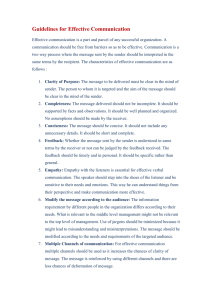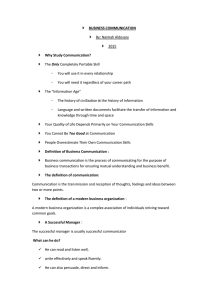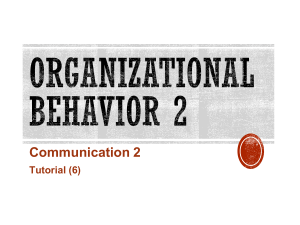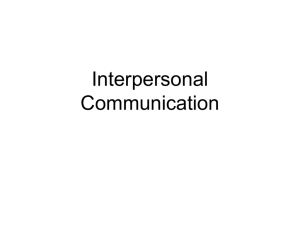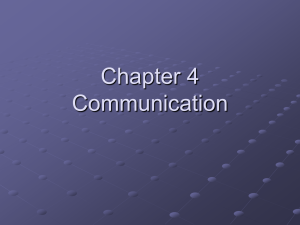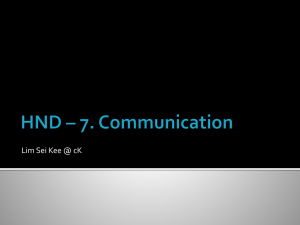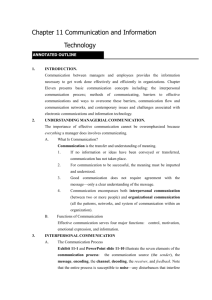Organizational Communication One of the most important aspects of
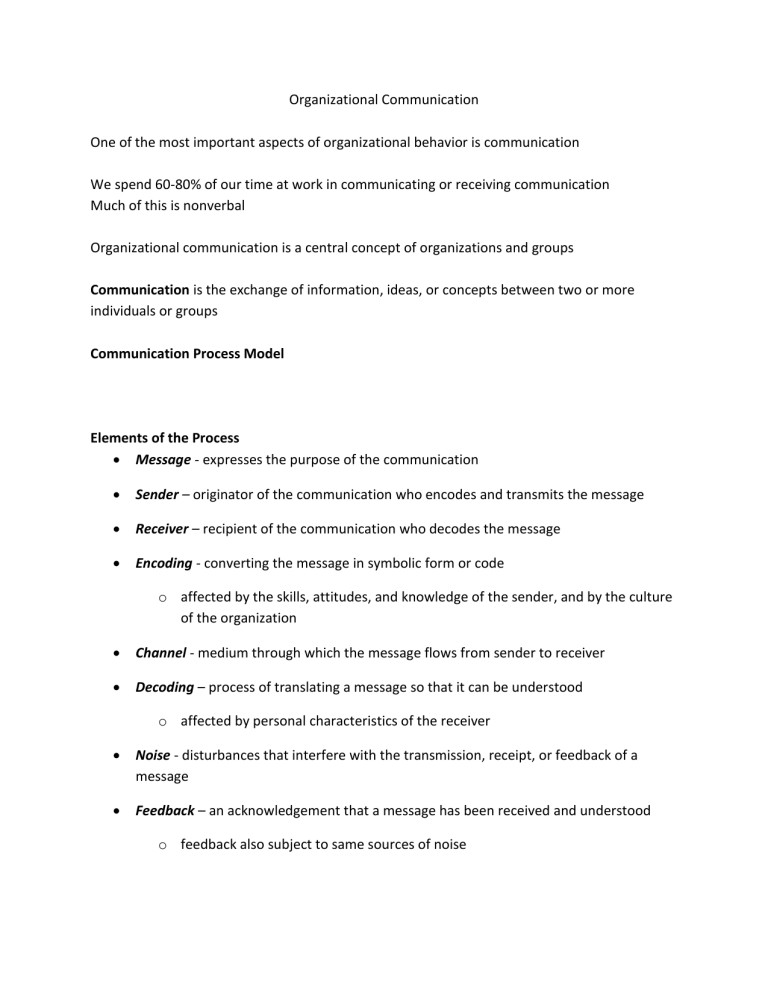
Organizational Communication
One of the most important aspects of organizational behavior is communication
We spend 60-80% of our time at work in communicating or receiving communication
Much of this is nonverbal
Organizational communication is a central concept of organizations and groups
Communication is the exchange of information, ideas, or concepts between two or more individuals or groups
Communication Process Model
Elements of the Process
Message - expresses the purpose of the communication
Sender – originator of the communication who encodes and transmits the message
Receiver – recipient of the communication who decodes the message
Encoding - converting the message in symbolic form or code o affected by the skills, attitudes, and knowledge of the sender, and by the culture of the organization
Channel - medium through which the message flows from sender to receiver
Decoding – process of translating a message so that it can be understood o affected by personal characteristics of the receiver
Noise - disturbances that interfere with the transmission, receipt, or feedback of a message
Feedback – an acknowledgement that a message has been received and understood o feedback also subject to same sources of noise
One Way vs. Two way Comm.
Communication does not always include feedback (Radio message)
Types of Org. Communication
Interpersonal communication - One person to another person
Intraorganizational communication - Within an organization between groups and indiv.
Interorganizational communication - Between organizations
Function of Org. Communication Scott and Mitchell (1976) - 4 general functions
Control – to clarify duties and to establish authority and responsibilities
Information – to provide information for the basis of decision making
Motivation – to elicit cooperation and commitment to the organizations goals
Emotions – to express feelings or emotions
Org. Communication Flow
Downward communications go from superior to subordinate
Lateral (horizontal) communications move between departments or between people in the same department
Upward communications move from subordinates to superiors
Downward Org. Communication Types:
Instructions or directions concerning job performance
Information about org. procedures or policies
Feedback
Information to coordinate work tasks
Lateral communication - Messages between 2 parties at the same level
Important for coordinating their activities to accomplishing a goal
Used to influence and persuade
Sharing of news and information
Maintaining interpersonal relationships
Upward communication
Primarily used to inform, influence and persuade
Upward communication informs higher level personnel about lower level workers’:
Fostering Upward Organizational Communication
Social gatherings
Union publications
Regular meetings
Performance appraisal meetings
Grievances
Attitude surveys
A suggestion system
An open door policy
Indirect measures
Barriers to Effective Communication
Ambiguous, Muddled Messages
Semantics or differences in meaning
Physical Barriers
Loss of Transmission
Failing to Communicate
Competition Barriers
Cultural, Linguistic, and Diversity Barriers
Not Listening
Communication distortion: the incorrect reproduction of objectively correct information
It involves changes in the content of the message by the sender either intentionally or not.
Often based on information overload and noise
Gaines (1980) 3 types of distortions o Puffing or exaggeration is accenting either favorable or unfavorable aspects of the information. (This called sharpening by others)
Sieving or filtering is selective withholding parts of the message
Leveling is the complete omitting or suppressing of information
Formal vs. Informal Communication
These distortions are evident in both the formal and informal types of organizational communication
The grapevine is an informal communication network within an organization.
Research reflects that about 75 % of the communication in the grapevine is accurate.
While the grapevine passes on useful information it also passes on rumor and gossip.
Gossip and Rumors
Gossip is news about the affairs of another, or personal information, be it positive or negative, spoken or in print.
Gossip has the potential to both create and destroy social bonds in a group.
Rumor is poorly substantiated information that is transmitted across the grapevine.
Organizational Communication Networks - combination of vertical and horizontal flows into a variety of patterns
Types of Networks
chain - communication flows according to the formal chain of command
wheel - flows between a clearly identifiable and strong leader and others in a work group or team
all-channel - flows freely among all members of a work team
No single network is best for all situations
Psychological Barriers
Perception o Selectivity/exposure filtering out of unpleasant things and focusing on or recalling things not heard. o Retention filtering of things that feel good, and the tendency to forget those things that are painful.
Experiential Barriers - The difficulty in understanding things not personally experienced.
Emotions -Emotions influence both what is said and what is heard.
Defensiveness - Adjustments people make to avoid acknowledging personal inadequacies that might reduce their self-esteem
